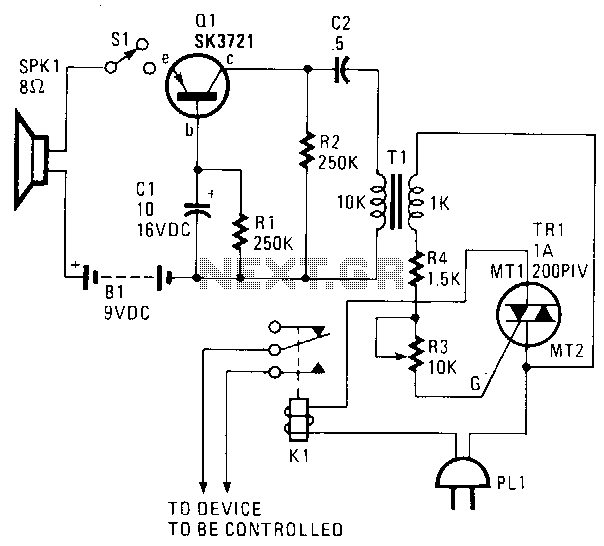
Voice-operated-switch

The sound captured by speaker SPKR1, functioning as a microphone, is transmitted to transistor amplifier Q1. The output from Q1 is connected to coupling transformer T1, which is utilized to activate the gate circuit of Triac TR1. Additionally, TR1 provides a latching effect to the operation of the relay.
The circuit described involves a sound detection and amplification system that leverages a speaker as a microphone. When sound waves are detected by SPKR1, they induce a small electrical signal that is then amplified by transistor Q1. This transistor operates in a common emitter configuration, providing significant gain to the input audio signal.
The amplified output from Q1 is fed into coupling transformer T1. The purpose of this transformer is twofold: it isolates the transistor stage from the subsequent circuit and converts the amplified signal into a suitable form for triggering the gate of Triac TR1. The use of a transformer also helps in impedance matching, ensuring maximum power transfer and preventing loading effects on the transistor.
Triac TR1 plays a critical role in controlling the relay's operation. When the gate of TR1 is triggered by the output from T1, the Triac enters a conductive state, allowing current to flow through the relay coil. This action causes the relay to latch, meaning it will remain energized even after the initial sound input ceases, until it is intentionally reset or interrupted. This latching behavior is advantageous in applications where a temporary sound detection should result in a sustained operation, such as in security alarms or automated systems.
Overall, the described circuit effectively combines audio detection, signal amplification, and relay control, showcasing a practical application of electronic components in sound-activated systems.The sound picked up by SPKRl, which acts as a microphone, is fed to transistor amplifier Ql. The output of Ql is applied across coupling transformer T1 and is used to drive the gate circuit of Triac TRl. TRl is used to lend a latching effect to the action of the relay. 🔗 External reference
The circuit described involves a sound detection and amplification system that leverages a speaker as a microphone. When sound waves are detected by SPKR1, they induce a small electrical signal that is then amplified by transistor Q1. This transistor operates in a common emitter configuration, providing significant gain to the input audio signal.
The amplified output from Q1 is fed into coupling transformer T1. The purpose of this transformer is twofold: it isolates the transistor stage from the subsequent circuit and converts the amplified signal into a suitable form for triggering the gate of Triac TR1. The use of a transformer also helps in impedance matching, ensuring maximum power transfer and preventing loading effects on the transistor.
Triac TR1 plays a critical role in controlling the relay's operation. When the gate of TR1 is triggered by the output from T1, the Triac enters a conductive state, allowing current to flow through the relay coil. This action causes the relay to latch, meaning it will remain energized even after the initial sound input ceases, until it is intentionally reset or interrupted. This latching behavior is advantageous in applications where a temporary sound detection should result in a sustained operation, such as in security alarms or automated systems.
Overall, the described circuit effectively combines audio detection, signal amplification, and relay control, showcasing a practical application of electronic components in sound-activated systems.The sound picked up by SPKRl, which acts as a microphone, is fed to transistor amplifier Ql. The output of Ql is applied across coupling transformer T1 and is used to drive the gate circuit of Triac TRl. TRl is used to lend a latching effect to the action of the relay. 🔗 External reference